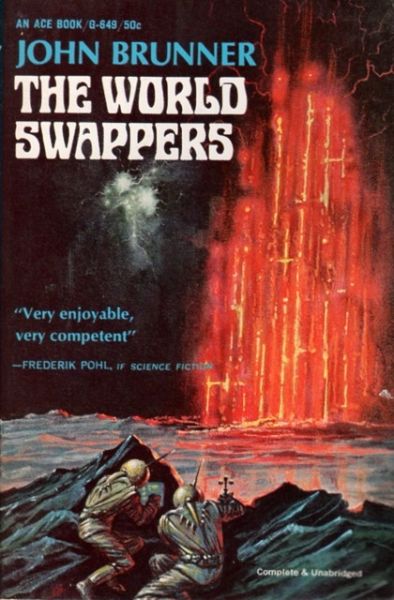Sky Full of Stars
The World Swappers
By John Brunner

28 Feb, 2023
John Brunner’s 1959 The World Swappers is a first-contact science fiction novel.
Four centuries earlier, bold visionaries embraced the promise of the stars. Hundreds of thousands left Earth to whatever dismal fate awaited them. They found thirty-one known habitable worlds within two hundred parsecs of Earth. The colonists had different notions of the utopias to which they aspired, but all of them found difficulty in achieving them.
Meanwhile, Earth did not descend into the over-populated, poverty-stricken hellhole predicted by doomsayers. Twenty-sixth century Earth is rich and lazy. However, the end of the golden age is in sight, unless adjustments are made in interstellar relations, adjustments that would allow emigration to restart.
Top oligarch Bassett is that confident he alone has the vision and the resources needed to restart and manage emigration. Shadowy cabal leader Uncredited social activist Saïd Counce knows that Bassett’s schemes are doomed. Were that not serious enough, Counce knows that the alien Others are about to stumble across humanity.
Counce and his carefully selected cabal are idealistic when it comes to their long-term goal (protecting the human species), but unflinchingly pragmatic when it comes to means (you can’t make an omelet without breaking eggs). They have an edge: they have discovered the secret to interstellar teleportation and as a side effect, they are also immortal. Death is temporary if you have saved a teleport pattern. Counce and his deathless co-conspirators have a long-term view impossible for poor mortal Bassett. They are working to prepare Earth and Earth’s colonies for the arrival of the Others.
Ymir is perhaps the least habitable planet occupied by humans. The religious fanatics who call it home revel in the mortifications the icy world imposes on its ten million inhabitants. At least, the adults do. Thanks to the methodical efforts of Counce’s cabal, Ymir’s young people are not at all certain of the wisdom of their elders.
Ymir is a world in the crosshairs of the Others. The Others evolved on a colder world than Earth. For them, Ymir would be heaven. Through means unknown, the aliens have discovered Ymir. It can only be a matter of time before they stumble over the human settlers, and the fact that humans are not native to Ymir.
Thus far, Counce’s cabal has been content to monitor the aliens from afar, rather than reveal humanity’s existence by attempting open contact. Now it is clear contact is inevitable. Will the aliens try to take Ymir for their own. Is war between human and alien inevitable? Or can the two crises facing humans be used to solve each other?
An extraneous factor intrudes: a rich man whose ambition far exceeds his competence.
~oOo~
Perhaps because Counce and company are immortals living among mortals, they are incredibly callous. A young woman is enticed to leave Ymir; the intent is to lure Bassett into kidnapping and mind-probing her. It is expected that what Bassett learns will nudge him towards the realization that while the colonies are not likely to accept Terrans any time soon, migration between the colonies is workable. To ensure that isolationist Ymir will be willing to send emigrants, the cabal orchestrates an embargo that catapults Ymir into famine, social collapse, and cannibalism.
Presumably, Counce has been sitting on the secret of teleportation for three centuries because Man is Not Ready to have both galactic range teleportation and immortality. Still, probably best not to dwell overlong on how Counce could easily provide the means by which vast populations could leap-frog the colonies to settle as yet undiscovered Earthlike worlds1.
This book appears to be a hastily cobbled-together novel about a self-selected oligarchy struggling to save humanity from itself. There are points of interest — the vexation the colonies feel at the impudence of Earth to insist on being fat, lazy, and far more successful is pretty funny — but the plot depends more on velocity than logic. Why, for example, would Counce confront Bassett in a way that exposes the secret of teleportation when more subtle alternatives had to exist?
Perhaps Brunner could have made more of this book had he taken the time, but of course, Brunner’s professional strategy at this point in his career was to write as quickly as possible, in order to maximize sales and income. Maybe I am being optimistic about the novel’s flaws being fixable, as this is one of the older works Brunner didn’t revise. There was a mid-1970s reprint, but there is no indication it is different from the original.
I am wrestling here with a puzzler. On the one hand, if I review Brunner’s early works, I can then contrast them with later works to show how much he grew as an author. On the other hand, many early Brunner works are, well, fairly dreadful. At least The World Swappers is better than Galactic Storm.
The World Swappers is available here (Amazon US), here (Amazon Canada), here (Amazon UK), and here (Barnes & Noble). Since all current editions appear to be ebooks, it is not available from Book Depository. It’s is probably available from Chapters-Indigo (it is definitely listed on Kobo) but their search engine is still broken.
1: If there are thirty Earthlike worlds within 200 parsecs, simple geometry suggests there are almost 250 within 400 parsecs.
There appears to be one world per million cubic parsecs. Since there are 0.14 stars per cubic parsec in our region of the galaxy, that suggests about one sufficiently Earthlike world per seven million stars. Since the Milky Way has hundreds of billions of stars, there could be many thousands of Earthlike worlds. However, the presence of the Others suggests that many will be occupied.
